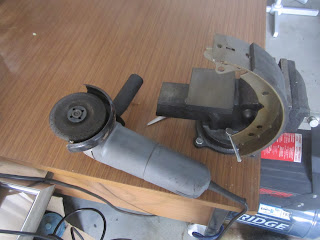 |
| Brake line connections |
Normally 200-300 cc brake fluid is enough to fill an average car brake system. But because this is about filling an empty system you also have to get rid of the air by bleeding and I needed around 600-800 cc to get the job done.
So filled the system through the brake fluid reservoir and started checking all the brake line connections. I counted 32 connections on this duel brake system. 2 of them were leaking right away but with a 1/8 extra turn the leaking stopped.
I jacked the car a bit higher at the rear hoping that most of the air in the system would go there.
The Volvo 122S with the dual line system has 8 bleed valves; each front caliper has 3 valves and each rear wheel one (just above where the brake line goes into the brake/wheel cylinder).
 |
| 3 bleed valves (covered with rubber caps) for the front brake calipers |
The brake bleeding sequence for the Volvo 122S dual line system:
- Left rear wheel
- Left front wheel, upper, inner
- Right front wheel, upper, inner
- Right rear wheel
- Right front wheel, outer
- Right front wheel, lower, inner
- Left front wheel, outer
- Left front wheel, lower, inner
Normally you need 2 people to bleed the brakes; one pumping the brake pedal and the other opening and closing the bleed valves. But with some simple self made tools you can do it alone.
You need two "tools" to make brake bleeding easy.
The first one is a cap with a valve for your brake fluid reservoir and the second one is a clear hose with a small valve at the end hanging in a jar filled with brake fluid.
 |
| 2 Brake bleeding tools |
I bought a $4,- dollar spare cap, drilled a hole in it and tapped in an old bike valve tube. I used some Teflon tape an two o-rings to make it air tight. I screwed it on the reservoir and now I could put pressure on the brake system with a simple hand pump. Not to much, 3-4 pumps are enough.
 |
| Brake fluid reservoir cap with "pressure" valve |
 |
| Modified cap on brake fluid reservoir |
When you open a bleed valve you want the air going out, not air going in! So you need a clear plastic tube that fits the bleed valve, push a bicycle tube valve in the other end (top of the valve in the tube!) and let it hang in a glass jar filled with fresh brake fluid. The valve will let the old brake fluid and air going out but prevents air from going in when the pressure in the system isn't high enough.
 |
| bicycle valve in bottom of clear tube |
When I put some pressure on the braking system more the half of the connections started sweating, so I fixed this first (1/8 -1/4 turn extra) before bleeding the system.
The tools did their job and after bleeding all the valves twice I'm pretty sure there's now only brake fluid in the system. Don't forget to check the level in the brake fluid reservoir while bleeding and top up when neccessary. Btw I took all the wheels of which will make the bleeding a lot easier.
 |
| Bleeding the dual brake system |
While the car was still jacked I tested the brakes by turning the wheels as fast as possible by hand and then hit the brake pedal, all good.
The next test was driving the car on the driveway and hitting the brakes, very exiting .. the driveway was ca 35 m long and with the shed open I had an extra 10 m. The first time I drove really, really slow and hit the brakes, they worked! So this time I took of fast,put in in second gear and with a speed of ca 15 mph I hit the brakes again, it stopped again!
I could also feel the assistance of the brake servo so that one functioned too. Now it was time to check the unions and connections in the brake system again, ^#%#@$ half of them were sweating! Well it wasn't a real problem just some extra work tightening them and bleeding the system one more time just to make sure...











